Trigonometric Function Properties
VerifiedAdded on 2023/03/17
|7
|1405
|75
AI Summary
This document explains the properties of trigonometric functions, including amplitude, period, and maximum/minimum values. It also provides examples and graphs to illustrate these concepts.
Contribute Materials
Your contribution can guide someone’s learning journey. Share your
documents today.

1. Consider the trigonometric function f ( t )=−1+4 sin ( 1
2 π ( t−1 ) )
a) What is the amplitude of f ( t )?
b) What is the period of f ( t )?
c) What are the maximum and minimum values attained by f ( t )?
d) Sketch the graph of f ( t ) for t ∈ [−1,3 ]
Answer:
A sine wave of the form (Miller, 2010):
y ( t ) =D+ A sin ( B ( t +C ) )
has:
Amplitude = A
Period = 2 π
B
Phase shift = C (positive value means shift is to the left)
Vertical shift = D
f ( t )=−1+ 4 sin ( 1
2 π ( t−1 ) )
Comparing with the standard form ( y ( t ) ), we get:
A=4 , B= π
2 , C=−1 , D=−1
a) Amplitude of f ( t ) is A that is 4
b) Period of f ( t ) is:
Period= 2 π
B =2 π
π
2
=4
c) Maximum and minimum values of f ( t ):
f ( t )=−1+ 4 sin ( 1
2 π ( t−1 ) )
Maximum value of sin ( 1
2 π ( t −1 ) ) is 1 and minimum is -1 (Property of sine function)
therefore,
Max f ( t )=−1+ 4 · Max sin ( π
2 ( t−1 ) )=−1+4 · 1=3
2 π ( t−1 ) )
a) What is the amplitude of f ( t )?
b) What is the period of f ( t )?
c) What are the maximum and minimum values attained by f ( t )?
d) Sketch the graph of f ( t ) for t ∈ [−1,3 ]
Answer:
A sine wave of the form (Miller, 2010):
y ( t ) =D+ A sin ( B ( t +C ) )
has:
Amplitude = A
Period = 2 π
B
Phase shift = C (positive value means shift is to the left)
Vertical shift = D
f ( t )=−1+ 4 sin ( 1
2 π ( t−1 ) )
Comparing with the standard form ( y ( t ) ), we get:
A=4 , B= π
2 , C=−1 , D=−1
a) Amplitude of f ( t ) is A that is 4
b) Period of f ( t ) is:
Period= 2 π
B =2 π
π
2
=4
c) Maximum and minimum values of f ( t ):
f ( t )=−1+ 4 sin ( 1
2 π ( t−1 ) )
Maximum value of sin ( 1
2 π ( t −1 ) ) is 1 and minimum is -1 (Property of sine function)
therefore,
Max f ( t )=−1+ 4 · Max sin ( π
2 ( t−1 ) )=−1+4 · 1=3
Secure Best Marks with AI Grader
Need help grading? Try our AI Grader for instant feedback on your assignments.
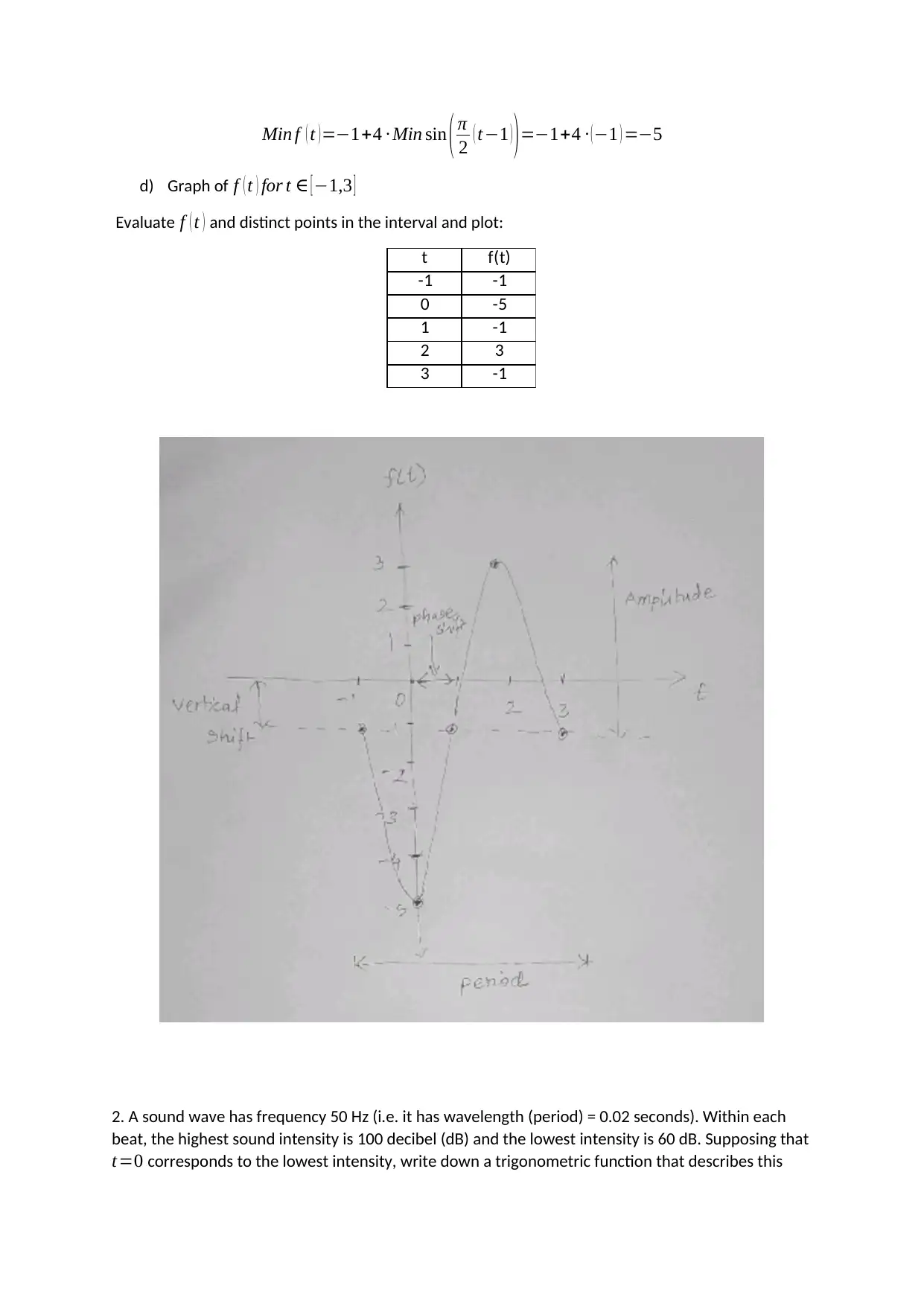
Min f ( t )=−1+4 · Min sin ( π
2 ( t−1 ) )=−1+4 · (−1 ) =−5
d) Graph of f ( t ) for t ∈ [−1,3 ]
Evaluate f ( t ) and distinct points in the interval and plot:
t f(t)
-1 -1
0 -5
1 -1
2 3
3 -1
2. A sound wave has frequency 50 Hz (i.e. it has wavelength (period) = 0.02 seconds). Within each
beat, the highest sound intensity is 100 decibel (dB) and the lowest intensity is 60 dB. Supposing that
t=0 corresponds to the lowest intensity, write down a trigonometric function that describes this
2 ( t−1 ) )=−1+4 · (−1 ) =−5
d) Graph of f ( t ) for t ∈ [−1,3 ]
Evaluate f ( t ) and distinct points in the interval and plot:
t f(t)
-1 -1
0 -5
1 -1
2 3
3 -1
2. A sound wave has frequency 50 Hz (i.e. it has wavelength (period) = 0.02 seconds). Within each
beat, the highest sound intensity is 100 decibel (dB) and the lowest intensity is 60 dB. Supposing that
t=0 corresponds to the lowest intensity, write down a trigonometric function that describes this
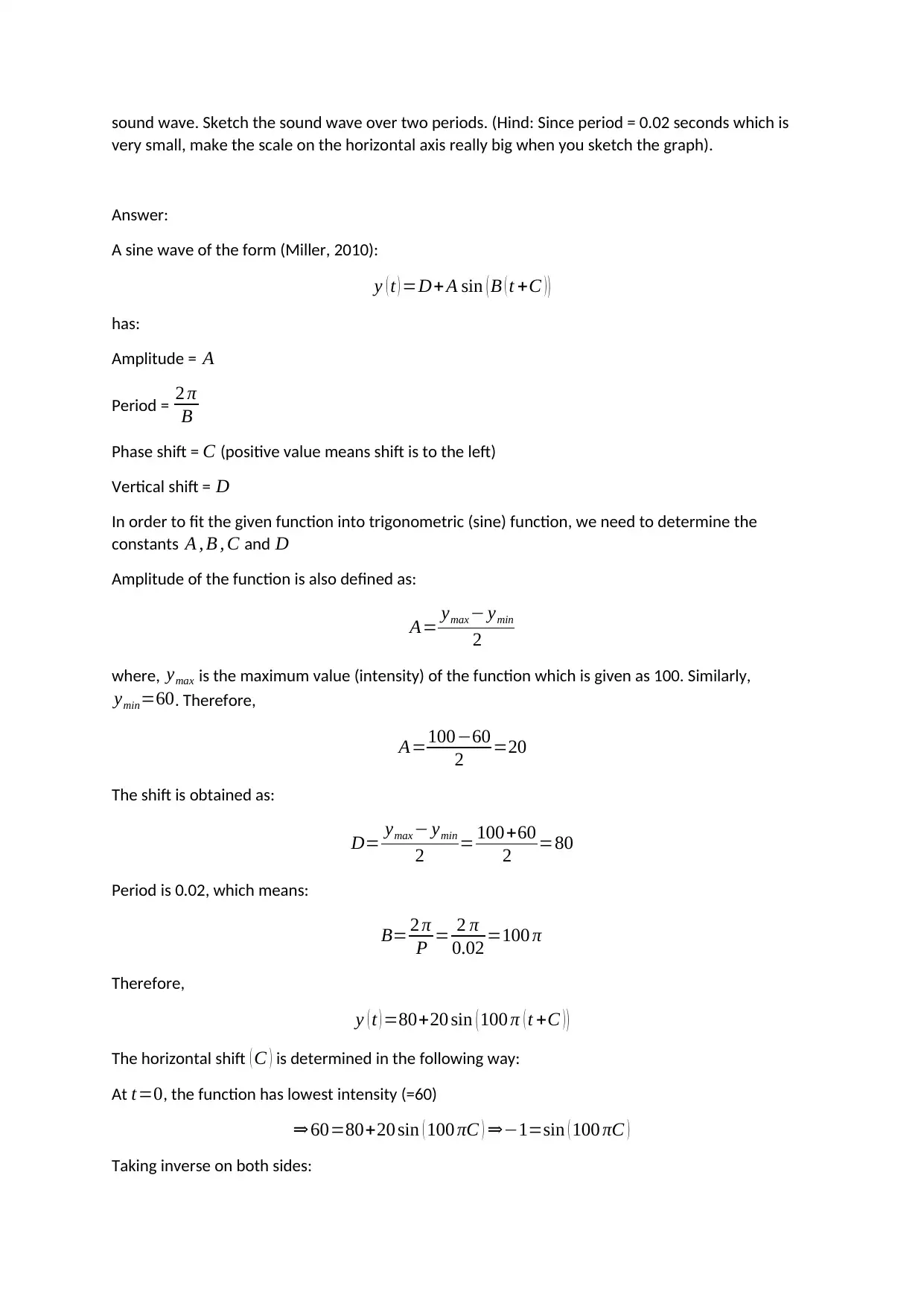
sound wave. Sketch the sound wave over two periods. (Hind: Since period = 0.02 seconds which is
very small, make the scale on the horizontal axis really big when you sketch the graph).
Answer:
A sine wave of the form (Miller, 2010):
y ( t ) =D+ A sin ( B ( t +C ) )
has:
Amplitude = A
Period = 2 π
B
Phase shift = C (positive value means shift is to the left)
Vertical shift = D
In order to fit the given function into trigonometric (sine) function, we need to determine the
constants A , B , C and D
Amplitude of the function is also defined as:
A= ymax − ymin
2
where, ymax is the maximum value (intensity) of the function which is given as 100. Similarly,
ymin=60. Therefore,
A=100−60
2 =20
The shift is obtained as:
D= ymax− ymin
2 = 100+60
2 =80
Period is 0.02, which means:
B= 2 π
P = 2 π
0.02 =100 π
Therefore,
y ( t ) =80+20 sin ( 100 π ( t +C ) )
The horizontal shift ( C ) is determined in the following way:
At t=0, the function has lowest intensity (=60)
⇒ 60=80+20 sin ( 100 πC ) ⇒−1=sin ( 100 πC )
Taking inverse on both sides:
very small, make the scale on the horizontal axis really big when you sketch the graph).
Answer:
A sine wave of the form (Miller, 2010):
y ( t ) =D+ A sin ( B ( t +C ) )
has:
Amplitude = A
Period = 2 π
B
Phase shift = C (positive value means shift is to the left)
Vertical shift = D
In order to fit the given function into trigonometric (sine) function, we need to determine the
constants A , B , C and D
Amplitude of the function is also defined as:
A= ymax − ymin
2
where, ymax is the maximum value (intensity) of the function which is given as 100. Similarly,
ymin=60. Therefore,
A=100−60
2 =20
The shift is obtained as:
D= ymax− ymin
2 = 100+60
2 =80
Period is 0.02, which means:
B= 2 π
P = 2 π
0.02 =100 π
Therefore,
y ( t ) =80+20 sin ( 100 π ( t +C ) )
The horizontal shift ( C ) is determined in the following way:
At t=0, the function has lowest intensity (=60)
⇒ 60=80+20 sin ( 100 πC ) ⇒−1=sin ( 100 πC )
Taking inverse on both sides:
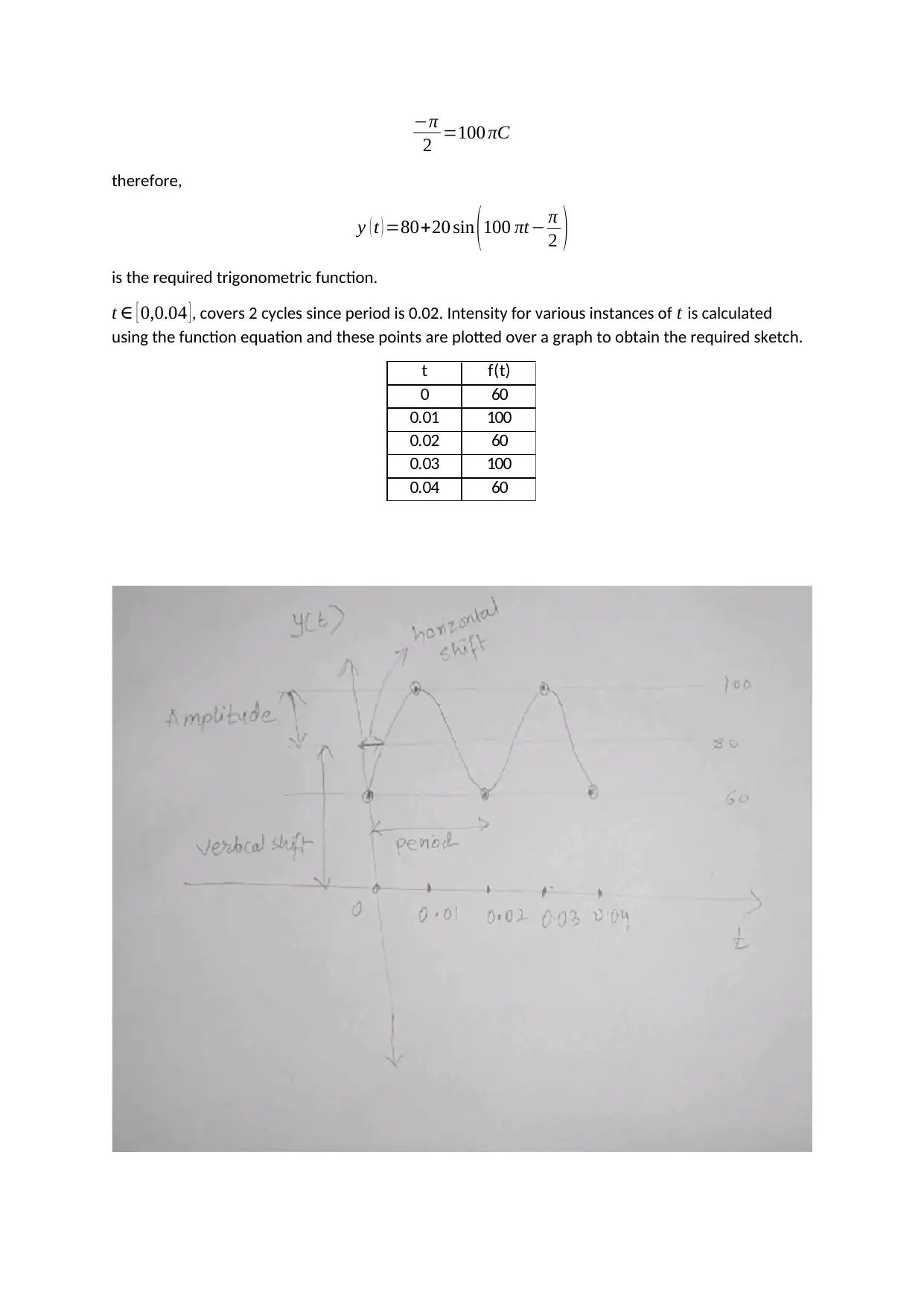
−π
2 =100 πC
therefore,
y ( t ) =80+20 sin (100 πt− π
2 )
is the required trigonometric function.
t ∈ [ 0,0.04 ] , covers 2 cycles since period is 0.02. Intensity for various instances of t is calculated
using the function equation and these points are plotted over a graph to obtain the required sketch.
t f(t)
0 60
0.01 100
0.02 60
0.03 100
0.04 60
2 =100 πC
therefore,
y ( t ) =80+20 sin (100 πt− π
2 )
is the required trigonometric function.
t ∈ [ 0,0.04 ] , covers 2 cycles since period is 0.02. Intensity for various instances of t is calculated
using the function equation and these points are plotted over a graph to obtain the required sketch.
t f(t)
0 60
0.01 100
0.02 60
0.03 100
0.04 60
Secure Best Marks with AI Grader
Need help grading? Try our AI Grader for instant feedback on your assignments.

3. The volume of water in a tank at a particular time (measured in seconds) is given by
V ( t ) =5 t ( 2−t ) m3. Find the rate of change of the volume of water in the tank from first principles
(using definition of rate of change).
Answer:
Volume of water in tank at any instant of time (t) is given by:
V ( t ) =5 t ( 2−t ) m3
¿ 10 t−5 t2
Rate of change of volume is (Stewart, 2012, 105-203):
d
dt V m3
sec
From the first principles:
d
dt V =li mh →0
V ( t +h )−V ( t )
h
Substitute the expression for V and evaluate the limit.
d
dt V =li mh →0
[ 10 ( t +h ) −5 ( t+h )2 ]− ( 10 t −5 t2 )
h =li mh →0
[ 10 t+10 h−5 ( t2 +h2 +2 th ) ]− ( 10 t−5 t 2 )
h =li mh → 0
[ 10 t+
¿ li mh →0 10−5 h−10 t
Taking limit to each term eliminates 5 h, as it becomes 0.
Therefore,
Rate of change of volume (Stewart, 2012, 105-203):
d
dt V =10−10 t m3
sec
4. Consider the function f ( x )=x2−1. Find the equation of the tangent to the graph of f ( x ) at x=3,
[NOTE: when calculating f ' ( 3 ), use first principles.]
Answer:
f ( x)=x2 – 1
Equation of tangent line to a curve at point ( x0 , y0 ) is given by the expression (Stewart, 2012, 105-
203):
y− y0=f ' ( x0 ) ( x−x0 )
V ( t ) =5 t ( 2−t ) m3. Find the rate of change of the volume of water in the tank from first principles
(using definition of rate of change).
Answer:
Volume of water in tank at any instant of time (t) is given by:
V ( t ) =5 t ( 2−t ) m3
¿ 10 t−5 t2
Rate of change of volume is (Stewart, 2012, 105-203):
d
dt V m3
sec
From the first principles:
d
dt V =li mh →0
V ( t +h )−V ( t )
h
Substitute the expression for V and evaluate the limit.
d
dt V =li mh →0
[ 10 ( t +h ) −5 ( t+h )2 ]− ( 10 t −5 t2 )
h =li mh →0
[ 10 t+10 h−5 ( t2 +h2 +2 th ) ]− ( 10 t−5 t 2 )
h =li mh → 0
[ 10 t+
¿ li mh →0 10−5 h−10 t
Taking limit to each term eliminates 5 h, as it becomes 0.
Therefore,
Rate of change of volume (Stewart, 2012, 105-203):
d
dt V =10−10 t m3
sec
4. Consider the function f ( x )=x2−1. Find the equation of the tangent to the graph of f ( x ) at x=3,
[NOTE: when calculating f ' ( 3 ), use first principles.]
Answer:
f ( x)=x2 – 1
Equation of tangent line to a curve at point ( x0 , y0 ) is given by the expression (Stewart, 2012, 105-
203):
y− y0=f ' ( x0 ) ( x−x0 )
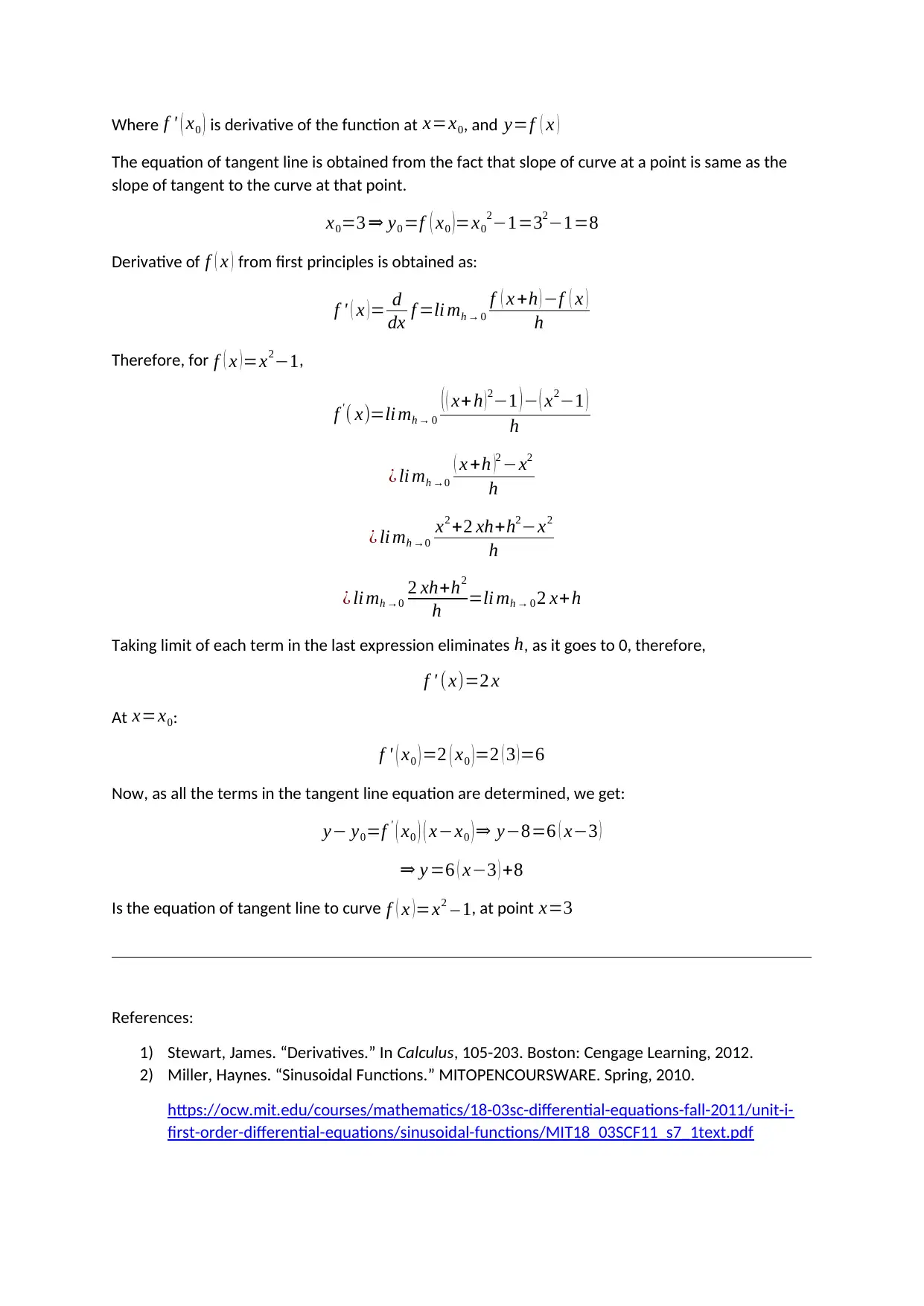
Where f ' ( x0 ) is derivative of the function at x=x0, and y=f ( x )
The equation of tangent line is obtained from the fact that slope of curve at a point is same as the
slope of tangent to the curve at that point.
x0=3 ⇒ y0 =f ( x0 )=x0
2−1=32−1=8
Derivative of f ( x ) from first principles is obtained as:
f ' ( x )= d
dx f =li mh → 0
f ( x +h ) −f ( x )
h
Therefore, for f ( x )=x2−1,
f ' ( x)=li mh → 0
( ( x+h ) 2−1 ) − ( x2−1 )
h
¿ li mh →0
( x +h )2 −x2
h
¿ li mh →0
x2 +2 xh+h2−x2
h
¿ li mh →0
2 xh+h2
h =li mh → 0 2 x+h
Taking limit of each term in the last expression eliminates h, as it goes to 0, therefore,
f ' ( x)=2 x
At x=x0:
f ' ( x0 ) =2 ( x0 )=2 ( 3 )=6
Now, as all the terms in the tangent line equation are determined, we get:
y− y0=f ' ( x0 ) ( x−x0 ) ⇒ y−8=6 ( x−3 )
⇒ y =6 ( x−3 ) +8
Is the equation of tangent line to curve f ( x ) =x2 – 1, at point x=3
References:
1) Stewart, James. “Derivatives.” In Calculus, 105-203. Boston: Cengage Learning, 2012.
2) Miller, Haynes. “Sinusoidal Functions.” MITOPENCOURSWARE. Spring, 2010.
https://ocw.mit.edu/courses/mathematics/18-03sc-differential-equations-fall-2011/unit-i-
first-order-differential-equations/sinusoidal-functions/MIT18_03SCF11_s7_1text.pdf
The equation of tangent line is obtained from the fact that slope of curve at a point is same as the
slope of tangent to the curve at that point.
x0=3 ⇒ y0 =f ( x0 )=x0
2−1=32−1=8
Derivative of f ( x ) from first principles is obtained as:
f ' ( x )= d
dx f =li mh → 0
f ( x +h ) −f ( x )
h
Therefore, for f ( x )=x2−1,
f ' ( x)=li mh → 0
( ( x+h ) 2−1 ) − ( x2−1 )
h
¿ li mh →0
( x +h )2 −x2
h
¿ li mh →0
x2 +2 xh+h2−x2
h
¿ li mh →0
2 xh+h2
h =li mh → 0 2 x+h
Taking limit of each term in the last expression eliminates h, as it goes to 0, therefore,
f ' ( x)=2 x
At x=x0:
f ' ( x0 ) =2 ( x0 )=2 ( 3 )=6
Now, as all the terms in the tangent line equation are determined, we get:
y− y0=f ' ( x0 ) ( x−x0 ) ⇒ y−8=6 ( x−3 )
⇒ y =6 ( x−3 ) +8
Is the equation of tangent line to curve f ( x ) =x2 – 1, at point x=3
References:
1) Stewart, James. “Derivatives.” In Calculus, 105-203. Boston: Cengage Learning, 2012.
2) Miller, Haynes. “Sinusoidal Functions.” MITOPENCOURSWARE. Spring, 2010.
https://ocw.mit.edu/courses/mathematics/18-03sc-differential-equations-fall-2011/unit-i-
first-order-differential-equations/sinusoidal-functions/MIT18_03SCF11_s7_1text.pdf
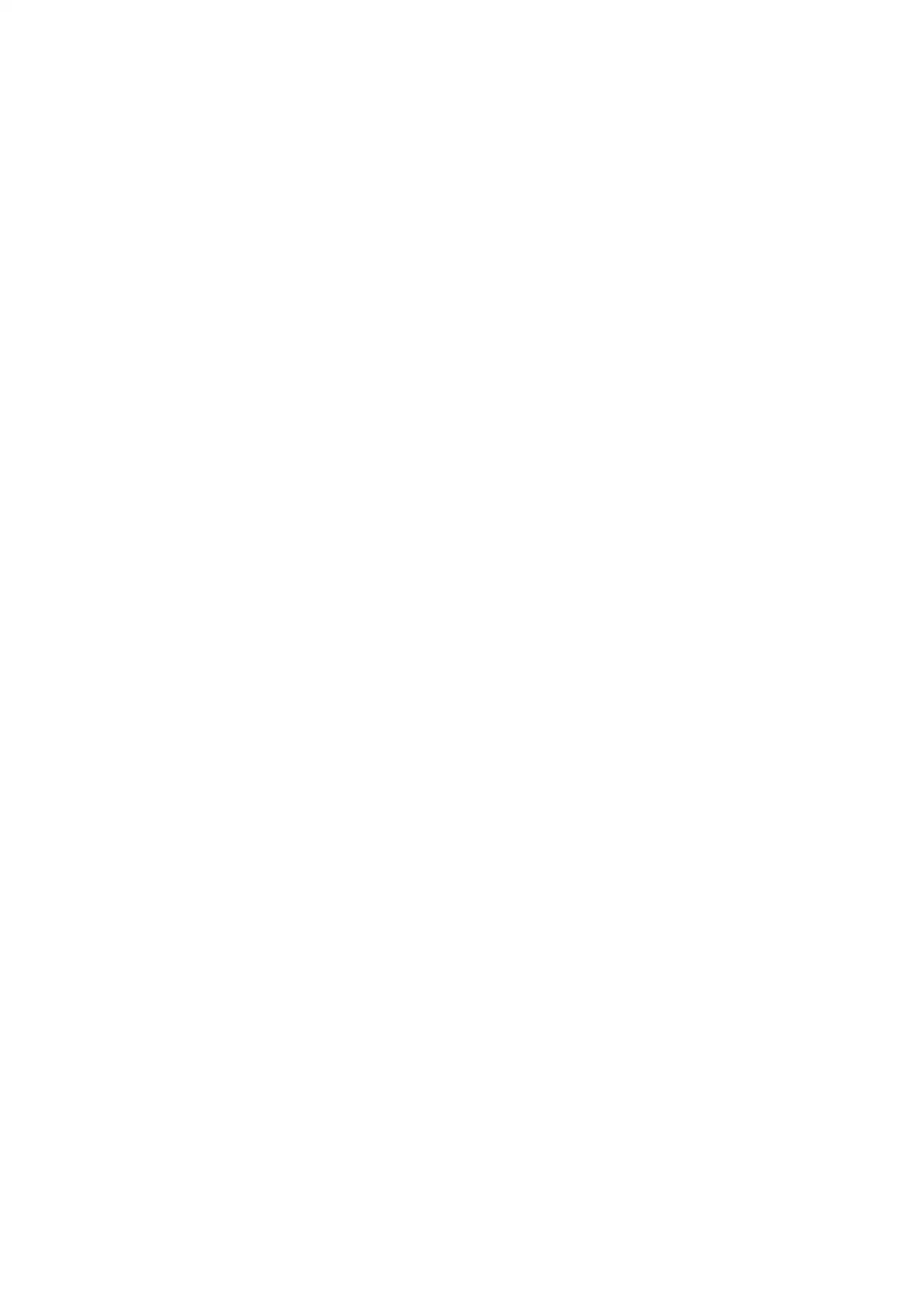
1 out of 7
Related Documents
Your All-in-One AI-Powered Toolkit for Academic Success.
+13062052269
info@desklib.com
Available 24*7 on WhatsApp / Email
![[object Object]](/_next/static/media/star-bottom.7253800d.svg)
Unlock your academic potential
© 2024 | Zucol Services PVT LTD | All rights reserved.





